
By Susan Harris*
Carbon tariffs on international goods being imported into the European Union (EU) may have been first mooted by European Commission (EC) officials 18 years ago at the 2005 International Sustainability Conference in Basel, Switzerland. The EC officials discussed a four-point plan to reduce carbon emissions - voluntary standards - industry standards - regulation - carbon tariffs. They commented that if the first step didn't work then they would move on to the next.
The EU Carbon Border Adjustment Mechanism (CBAM) regulation entered into force on 16 May this year. There will be a transitional pilot phase from 1 October where it applies to certain carbon intensive goods with the most risk of carbon leakage (production could shift to other nations with weaker climate rules): cement, iron and steel, aluminium, fertilisers, electricity and hydrogen.
Importers will be asked to collect embedded greenhouse gas emission (GHG) data for their products beginning as of 1 October 2023 (fourth quarter), but their first report won't be required until the end of January 2024.
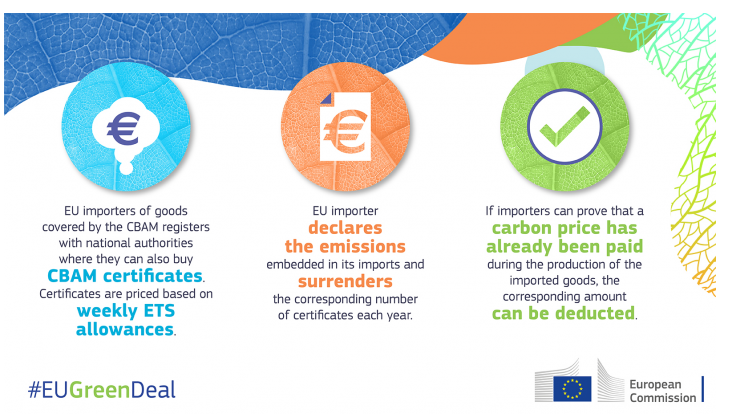
Source: European Commission 2023.
The permanent system will apply from 1 January 2026. Importers will need register with national authorities (eg. France, Germany), declare each year the quantity of goods imported during the preceding year, and its embedded GHG (which include transportation emissions), and buy CBAM Certificates to cover the embedded GHG.
They will then need to surrender the corresponding number of CBAM certificates. The price of the certificates will be based on the weekly average auction price of EU ETS (Emissions Trading Scheme) allowances in €/tonne of carbon emitted.
If importers can prove the carbon price has already been paid during production, the corresponding EU carbon debt can be waived. Notice the CBAM are like voluntary carbon credits - they cannot be traded between importers and can only be surrendered once. From 1 January 2026, EU importers will have to start paying the difference between New Zealand carbon credits (NZU) and EU carbon credits (EUR).
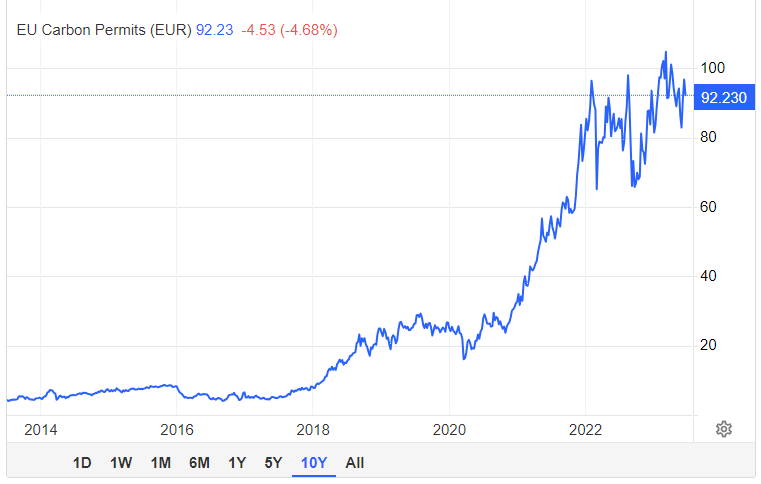
Source: Trading Economics 260623.
Historically the New Zealand carbon price (NZU) has always tracked significantly below the EUR price. Over the past five years the value of NZUs has been running about half the value of the EU. Recent policy settings have seen that gap broaden to $NZD100 to $NZD120, with NZUs currently worth less than a third of the EURs.
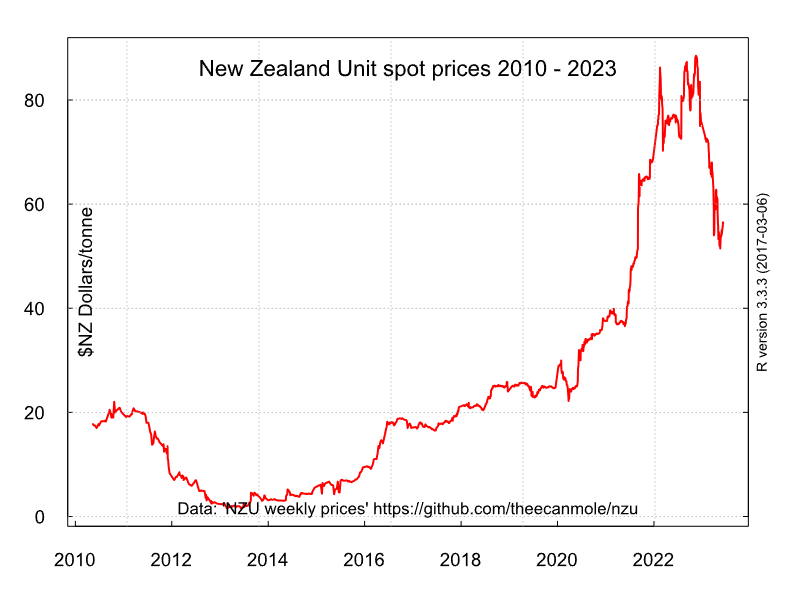
There have been several attempts in the USA to bring in carbon pricing and carbon tariffs at the border. The latest bipartisan proposal has senators from both parties signed on to legislation that would calculate the emissions intensity of industrial materials produced in the United States.
This is a step toward a USA-version of a CBAM, with tariffs on carbon-intensive imports like aluminium, iron, steel, plastic, crude oil, lithium-ion batteries, solar panels and wind turbines - notice a wider scope than the EU version.
The US Department of Energy has two years to work out the carbon intensity of these products made in the USA, and other work is proceeding to facilitate the development of the USA-CBAM.
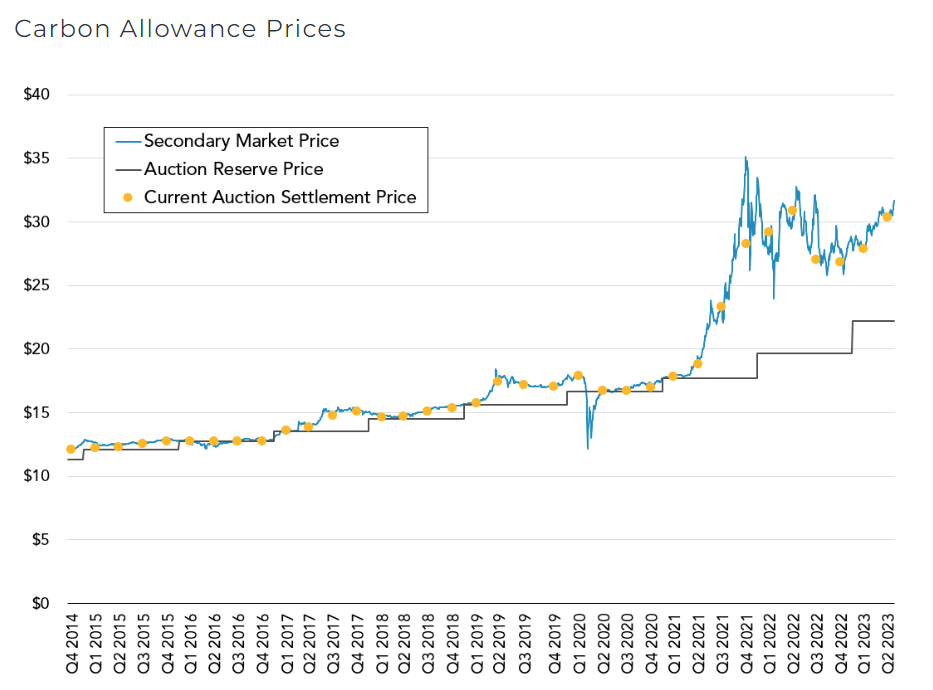
Source: California Air Resources Board 2023.
At present there are five ETS operative in the USA and three under consideration. Each covers different industry sectors, and credit values range from $USD0 (free allowance) to $USD107 in Oregon.
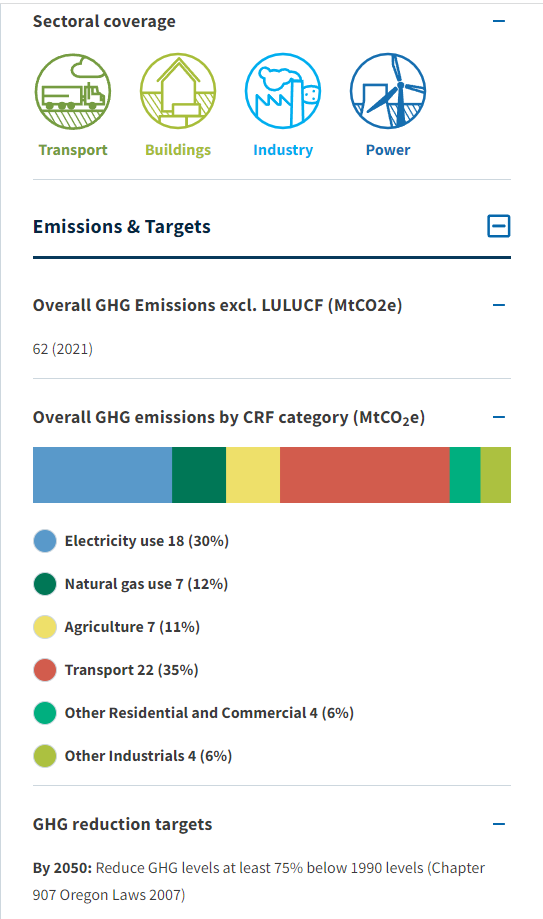
A USA carbon tariff price of US$55 has been suggested, as has linkage with the EU CBAM by large multi-nationals. New Zealand's carbon price, especially recently, lags significantly behind the suggested USA carbon tariff at only about half its value.
The major conclusions from this brief analysis of developing international carbon tariff systems are that:
1) Carbon tariffs are being developed by two of our most important premium export destinations - the EU and USA - that is, countries rich enough to pay premium prices for New Zealand exports;
2) Exporters need to know their product's embedded GHG tonnage;
3) New Zealand's ETS needs price strengthening to minimise carbon tariff costs on exporters;
4) New Zealand has very little, if any, control on the scope and cost of carbon tariffs even with our fair-trade agreements;
5) Industries not sheltered by the NZETS are the most exposed to carbon tariff risk in future; and,
6) As an export nation and as individual exporters, we need to develop smart strategies now to take advantage of the changes coming in the next five to 10 years and minimise financial exposure.
*Susan Harris is Principal Scientist at GreenXperts Limited, a New Zealand-based sustainability consultancy involved in numerous carbon and land management projects. Susan was on the science team that helped the New Zealand Government create the New Zealand Emissions Trading Scheme. Susan worked on emission factors with other colleagues at that time.
21 Comments
Don’t these fools get it, it’s about resource draw down, not carbon. Carbon dioxide is irrelevant. With the US dollar is worth to 26MB (and growing) of entropy, there is no option but to sterilise the developing world and switch to organic gardening. Quantum tunnelling does NOT cause information to evaporate, so there can be no return on the capital stock post 1973. The entire quack economics profession has ignored this. The dollar has crossed the event horizon and the worst is yet to come!
You're either getting a bit closer, or taking the p....:)
Carbon dioxide is not irrelevant, it is merely one factor in what is becoming known as the Polycrisis.
https://surplusenergyeconomics.wordpress.com/2023/06/05/257-of-theory-a…
It would be good to have a mechanisim to keep this money in NZ , to be used for emission reduction here. Voluntary carbon payments perhaps , rather than pay a tariff in Europe , the exporter pays a voluntary equal amount here , and that goes into the emission reduction pool.
Yes, there is.
Rationing - the best version probably being TEQs.
How long the EU keeps this up, though, is anyone's guess; people like the writer (entirely intelligent and sincere) are in siloes; just look at what is going on in France, and relate that to what is going on in Ukraine - and they ARE related. If you reduce the energy going into the system, society starts squealing; from the bottom, up. That's France. As the screws come on further, artificial tariffs will be the first thing thrown over the side. As for the USA, it might well have Trump back next time - an all bets would be off.
The reality is simple - there is no financial accounting which can supplant (intended) physical sequestering. To date, only planting (seedlings, not full-grown trees) is viable, but we'd need to redress our global de-forestation to just be square with the card, before we could count additional carbon being sequestered - as set up, it's a shifted base-line fudge. Everything else is either a 'pay us for not doing what we were going to do' (again, invalid) or an artists' impression (doesn't yet exist). Sequestered properly, the current system could not afford itself. So it won't.
This leaves us asking why this article, now? And I can only surmise it's a cheerleader piece for a system which is in trouble. That's not good news for those who wish it gone - the bigger reason it's in trouble has everything else in trouble too.
As for that 'leaving money in NZ to....' , the whole point is that we have to do less. Not something else; less. By some orders of magnitude.
The article implies that if we link the NZ unit price to the EU one there will be no bill to pay, assuming the exports are from a field subject to the ETS and the money stays here. Who knows what the detail of the US one will be.
The problem is the NZ unit price has collapsed recently, and was never as expensive as the EU one, and would be unlikely to get there given how cheap it is to buy land and plant trees.
Everything to do with Mathusian elitism. Starve the poorest in the name of latest fad. Ireland 1840 redux.
"EU was planning a new initiative that would structurally decrease poorer nations' reliance on Russian fertilisers by helping them develop their own fertiliser plants.
But at a meeting with EU envoys last week, the EU Commission explicitly opposed the text, warning that supporting fertiliser production in developing nations would be inconsistent with the EU energy and environment policies, officials said."
Well yes and no. The environmentalists will argue that production shouldn't be offshored to other locations that are cheaper just because they don't pay for their emissions properly. And then the protectionists have leapt on this and are pushing as hard as they can.
The nonsense from Profile, is the same nonsense the late Bob Carter's final PP slide contained; a picture of a wide-eyed little African girl, a coal-fired plant, and why not give her a chance?
It's bollocks; that is a finite resource, so it contains only a temporary 'chance', followed by a whole lot of useless infrastructure decaying, and a population unable to get enough energy out of food-production. To give here a 'chance', everything had to be long-term-sustainable - including the energy-source.
Same with us, of course.
Fat Pat - it IS about the environment, and about the end of globalisation, and inevitably nations will revert to protectionism - because voters are local, not global.
You would have to be a special kind of evil to deny some of the poorest people on the planet access to affordable energy and fertiliser when you have the means to do so. More so when when the EU members states left these countries as basket cases in the post colonial era.
"WASHINGTON, Feb 26 (Reuters) - Senior officials from Europe have urged the World Bank’s management to expand its climate change strategy to exclude investments in oil- and coal-related projects around the world, and gradually phase out investment in natural gas projects, according to three sources familiar with the matter."
And above all, new taxes. There's a reason countries ignored Climate change reports for a couple of decades until they worked out how to make it taxable.
I'm currently overseas for a month travelling in oz & SE Asia. I can say that so far there's zero visible sign of climate related behaviour changes anywhere else nor the virtue signalling handwringing nonsense we see every day in nz to offset our 0.17% contribution to the world.
Thankfully we live in a temperate zone surrounded by ocean and fresh air.
This is all about German protectionism and tax gathering. Germany has become highly reliant on coal for electricity production, ironically caused by their war on fossil fuels and nuclear. add extremely high carbon pieces in the EU and it is the perfect storm. they need to tax imports to keep German industry competitive. All this will drive further inflation, social unrest and political instability.
Growth doesn't 'come from' anywhere. It comes from applying more energy. That drives more everything else, cover-word: infrastructure.
The problem is the supply of same, and China and the rest of the Brics are in exactly the same boat as the West. There is no real growth from here on; merely increasing competition for reducing stocks of things. China may end up the relatively-biggest hegemony, but it'll be smaller than the US was at peak.
Further confusion comes with using GDP as a measure - it counts negatives as positives, and fails to count stocks.
I don't know why we chase the EU for bad/low volume trade deals. They look like they are about to implode with all the civil unrest, infighting and self imposed sanctions. The number of consumers looking to buy our stuff will be less for few years, even if we do comply. We are much better chasing the new middle class in SEA and BRICS countries.
As much as like the sentiment. Excluding China, India has high tariffs to our dairy goods and I doubt if we'll get much change here in an FTA. Probably India for any concessions will require allowing 10,000 Indian chefs to be allowed in and another 100,000 students, a drop in the ocean for India. Both Nats and Labour would readily agree to this.
South Africa is a basket case so nothing there. Brazil maybe. Russia is off limits and unlikely for exports or imports for at least ten years.
There was only enough planet for a few to consume at our level. Depending on rate, that maybe peaked at 2 billion on the right side of the ledger. India and China are both at 1.4 billion, so even counting them, it's an either/or.
So many people start with their wished-for, them make the facts fit. It's a little like people saying they own a house - when the bank owns 75% of it. So too with the middle-classes; increasingly they are indebted, increasingly tapped-out. Indeed, I suggest we are trending to a graph with polarised humps, rather than a bell-curve.
We can notice that they are no longer citizens - they're consumers. Which begs the question: Of what?

We welcome your comments below. If you are not already registered, please register to comment.
Remember we welcome robust, respectful and insightful debate. We don't welcome abusive or defamatory comments and will de-register those repeatedly making such comments. Our current comment policy is here.